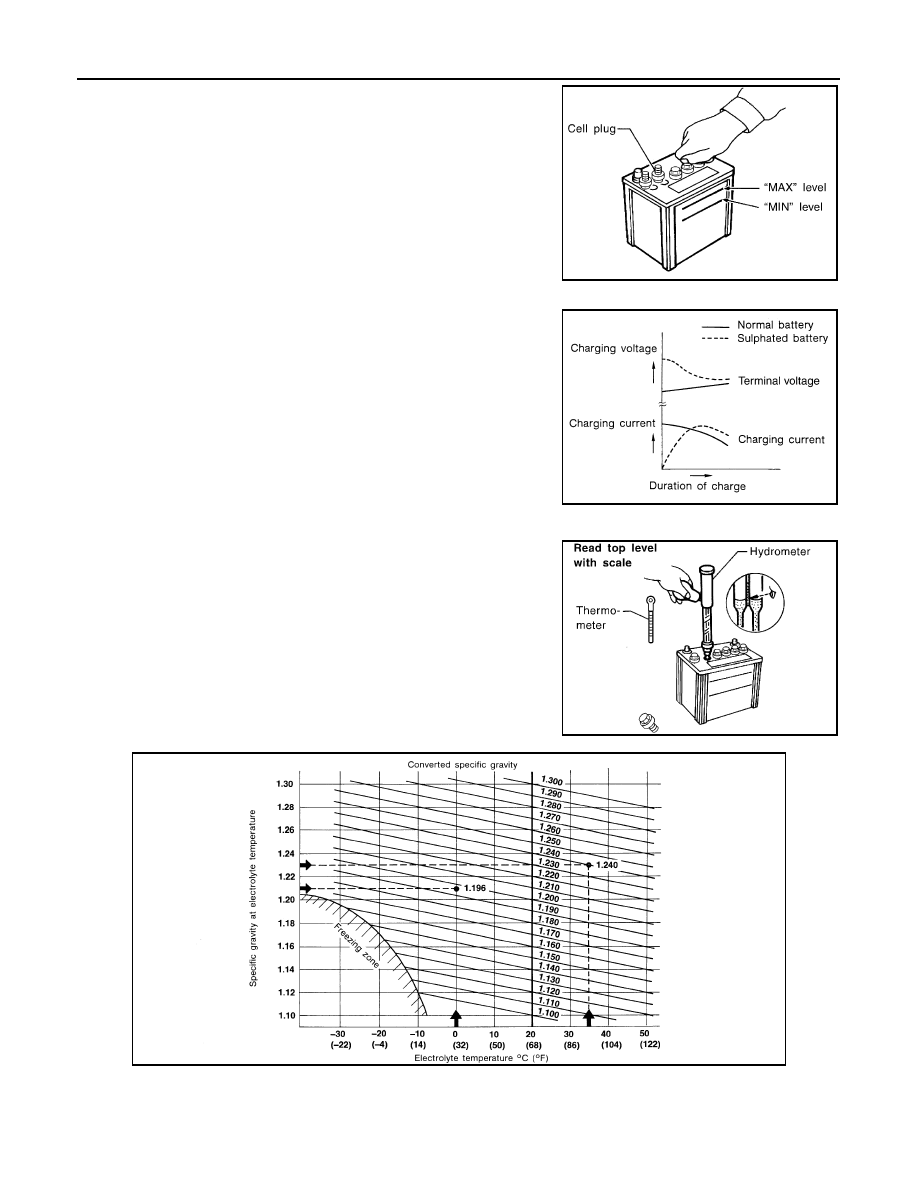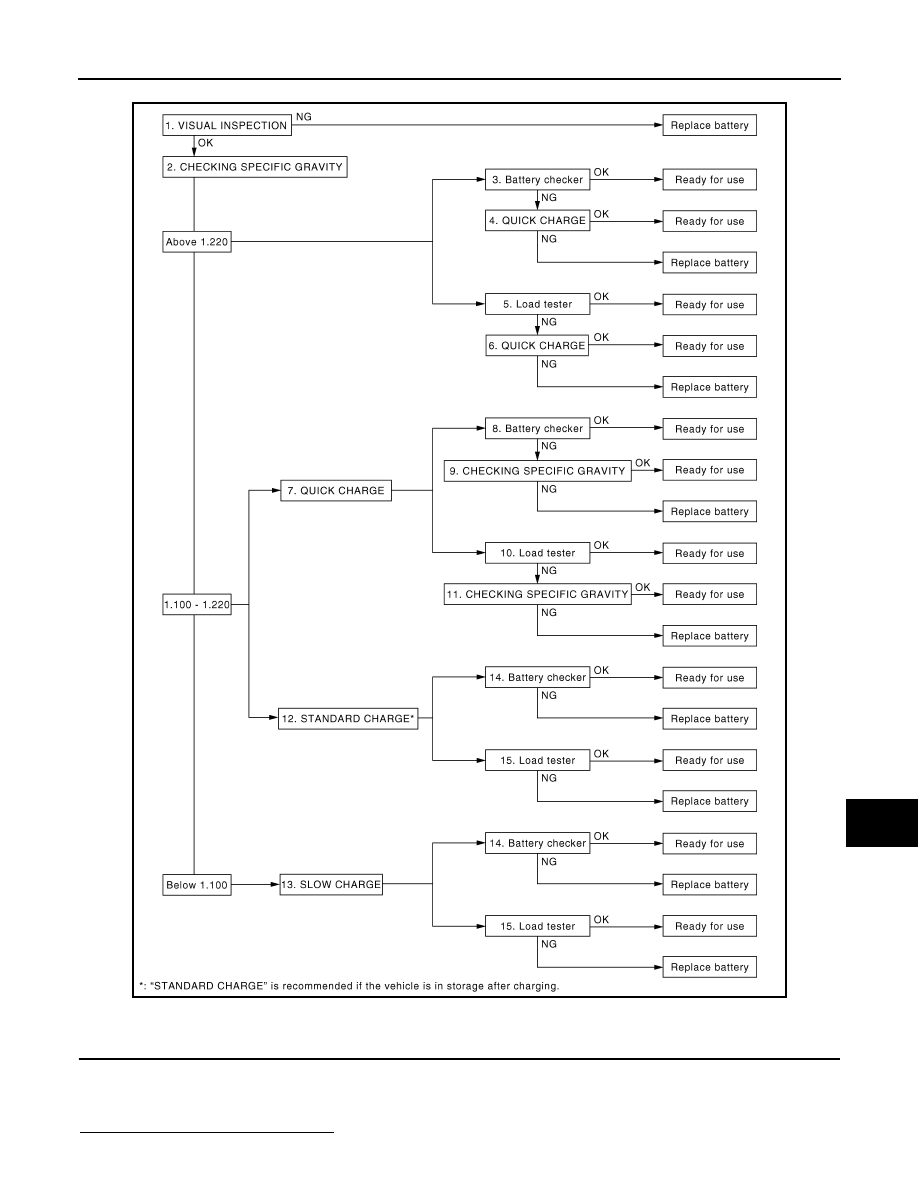Nissan Qashqai (2007-2010). Manual — part 1866
PG-2
SERVICE DATA AND SPECIFICATIONS
(SDS) . . . . . . . . . . . . . . ..
SERVICE DATA AND SPECIFICATIONS
(SDS) . . . . . . . . . . . . . . . .

PG
BATTERY
PG-3
< BASIC INSPECTION >
[POWER SUPPLY & GROUND CIRCUIT]
C
D
E
F
G
H
I
J
K
L
B
A
O
P
N
BASIC INSPECTION
BATTERY
How to Handle Battery
INFOID:0000000001026781
CAUTION:
• If it becomes necessary to start the engine with a booster battery and jumper cables, use a 12-volt
booster battery.
• After connecting battery cables, ensure that they are tightly clamped to battery terminals for good
contact.
• Never add distilled water through the hole used to check specific gravity.
METHODS OF PREVENTING OVER-DISCHARGE
The following precautions must be taken to prevent over-discharging a battery.
• The battery surface (particularly its top) should always be kept
clean and dry.
• The terminal connections should be clean and tight.
• At every routine maintenance, check the electrolyte level.
This also applies to batteries designated as “low maintenance” and
“maintenance-free”.
• When the vehicle is not going to be used over a long period of
time, disconnect the battery cable from the negative terminal. (If
the vehicle has an extended storage switch, turn it off.)
• Check the charge condition of the battery.
Periodically check the specific gravity of the electrolyte. Keep a
close check on charge condition to prevent over-discharge.
CHECKING ELECTROLYTE LEVEL
WARNING:
Never allow battery fluid to come in contact with skin, eyes, fabrics, or painted surfaces. After touch-
ing a battery, never touch or rub your eyes until you have thoroughly washed your hands. If acid con-
tacts eyes, skin or clothing, immediately flush with water for 15 minutes and seek medical attention.
MEL040F
ELA0349D
MEL042F

PG-4
< BASIC INSPECTION >
[POWER SUPPLY & GROUND CIRCUIT]
BATTERY
• Remove the cell plug using a suitable tool.
• Add distilled water up to the MAX level.
Sulphation
A battery will be completely discharged if it is left unattended
for a long time and the specific gravity will become less than
1.100. This may result in sulphation on the cell plates.
To determine if a battery has been “sulphated”, note its voltage
and current when charging it. As shown in the figure, less cur-
rent and higher voltage are observed in the initial stage of
charging sulphated batteries.
A sulphated battery may sometimes be brought back into ser-
vice by means of a long, slow charge, 12 hours or more, fol-
lowed by a battery capacity test.
SPECIFIC GRAVITY CHECK
1.
Read hydrometer and thermometer indications at eye level.
2.
Convert into specific gravity at 20
°
C (68
°
F).
Example:
• When electrolyte temperature is 35
°
C (95
°
F) and specific gravity of
electrolyte is 1.230, converted specific gravity at 20
°
C (68
°
F) is
1.240.
• When electrolyte temperature is 0
°
C (32
°
F) and specific gravity of
electrolyte is 1.210, converted specific gravity at 20
°
C (68
°
F) is
1.196.
Work Flow
INFOID:0000000000978143
MEL043F
PKIA2353E
MEL042FA
SEL007Z

PG
BATTERY
PG-5
< BASIC INSPECTION >
[POWER SUPPLY & GROUND CIRCUIT]
C
D
E
F
G
H
I
J
K
L
B
A
O
P
N
OVERALL SEQUENCE
DETAILED FLOW
1.
VISUAL INSPECTION
1.
Check battery case for cracks or bends.
2.
Check battery terminals for damage.
3.
If the difference between the max. and min. electrolyte level in cells is within 10 mm (0.39 in), it is OK.
Are these inspection results normal?
JPMIA0184GB

Нет комментариевНе стесняйтесь поделиться с нами вашим ценным мнением.
Текст